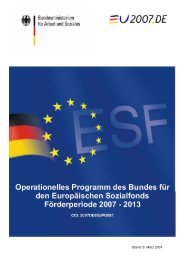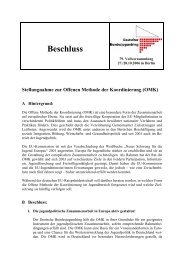6 Country Reports on Youth Work - Jugendpolitik in Europa
6 Country Reports on Youth Work - Jugendpolitik in Europa
6 Country Reports on Youth Work - Jugendpolitik in Europa
Create successful ePaper yourself
Turn your PDF publications into a flip-book with our unique Google optimized e-Paper software.
Possible <strong>in</strong>dicators<br />
at nati<strong>on</strong>al level (see<br />
page 70)<br />
F<strong>in</strong>d<strong>in</strong>gs: sectors of<br />
specific and related<br />
youth work (see page<br />
115 and country reports <strong>on</strong><br />
youth work page 30)<br />
Tak<strong>in</strong>g <strong>in</strong> c<strong>on</strong>siderati<strong>on</strong> the diversity of nati<strong>on</strong>al data about youth work<br />
and the difficulties that have to be faced when report<strong>in</strong>g at European<br />
level has to be comparative, some available basic <strong>in</strong>dicators could be<br />
identified as the start<strong>in</strong>g po<strong>in</strong>t for a future report<strong>in</strong>g structure. They<br />
are based <strong>on</strong> statistics available from EUROSTAT as well as <strong>on</strong> data<br />
from the Eurobarometer 2007 Survey <strong>on</strong> <strong>Youth</strong> and available nati<strong>on</strong>al<br />
data.<br />
In all European countries that participated <strong>in</strong> the study a wide range<br />
of youth work is available. In most countries we f<strong>in</strong>d at least the n<strong>in</strong>e<br />
field of of activities of youth work def<strong>in</strong>ed <strong>in</strong> this study (extracurricular<br />
youth educati<strong>on</strong>, <strong>in</strong>ternati<strong>on</strong>al youth work, open youth work,<br />
participati<strong>on</strong> and peer educati<strong>on</strong> preventi<strong>on</strong> of social exclusi<strong>on</strong>/youth<br />
social work, recreati<strong>on</strong>, youth counsell<strong>in</strong>g, youth <strong>in</strong>formati<strong>on</strong> and<br />
youth work <strong>in</strong> sports). Wherever there are gaps <strong>in</strong> the data available<br />
at nati<strong>on</strong>al level, <strong>in</strong>formati<strong>on</strong> about availability can be found <strong>in</strong> the<br />
local sett<strong>in</strong>g and vice versa. Extracurricular youth educati<strong>on</strong> and<br />
recreati<strong>on</strong>, each of them account<strong>in</strong>g for an average of 24%, are the<br />
most frequent activities offered.<br />
There are nevertheless important distorti<strong>on</strong>s at nati<strong>on</strong>al and <strong>in</strong>deed <strong>in</strong><br />
some cases at local level – the c<strong>on</strong>sequence of divergences <strong>in</strong> each<br />
country’s understand<strong>in</strong>g of what c<strong>on</strong>stitutes youth work, of differences<br />
<strong>in</strong> the categories used <strong>in</strong> the survey, and of the distributi<strong>on</strong> of<br />
adm<strong>in</strong>istrative resp<strong>on</strong>sibility. One example of this is youth sport. In<br />
countries where sport is c<strong>on</strong>sidered part and parcel of youth work,<br />
and where it is documented as such, it accounts for a major<br />
quantitative share – at least <strong>on</strong>e third to half – of all activities offered.<br />
Another example is, <strong>in</strong> Germany, activities for the preventi<strong>on</strong> of social<br />
exclusi<strong>on</strong>. No <strong>in</strong>formati<strong>on</strong> is available for this field of youth work, <strong>on</strong>e<br />
of the reas<strong>on</strong>s be<strong>in</strong>g that most of the activities offered are activities<br />
relat<strong>in</strong>g to the employment market and fall<strong>in</strong>g with<strong>in</strong> the competence<br />
of the job centres.<br />
In all countries it can be observed that youth work is performed by<br />
different types of providers (public, semi-public and n<strong>on</strong>-public or<br />
voluntary). Only <strong>in</strong> Spa<strong>in</strong> could a predom<strong>in</strong>ance of public <strong>in</strong>stituti<strong>on</strong>s<br />
be traced, as 60% of youth work activities at local level are provided<br />
by public <strong>in</strong>stituti<strong>on</strong>s. In all other European countries, the n<strong>on</strong>-public<br />
sector, with a share of at least 65%, represents the ma<strong>in</strong> provider.<br />
7

















